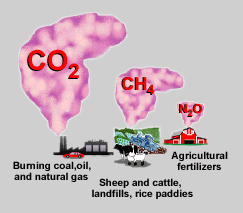| ||||||||||||||||||||||||||||
Proactive disclosure Print version |  Temperature rising: Climate change in southwestern British Columbia Why is climate changing now? The Earth's solar energy budget Nearly one third of the incoming short-wave radiation from the Sun is reflected back into space by clouds and the Earth's surface. The remainder is absorbed by the Earth and its atmosphere. The heat-trapping quality of the atmosphere, the so-called 'greenhouse effect,' is caused by gases that absorb long-wave radiation emitted by the Earth.
The carbon balance Carbon is present in the atmosphere and oceans. Huge amounts of carbon are also stored within the Earth in fossil fuels and sedimentary rocks, and on the Earth's surface in vegetation and soils. Carbon occurs in the atmosphere mainly in the form of CO2. Before the Industrial Revolution, additions of CO2 and other greenhouse gases to the atmosphere were balanced by removals, thus atmospheric concentrations of these gases did not vary much. Greenhouse gases: the big three  The main energy-absorbing or greenhouse gases, aside from water vapour (H2O), are carbon dioxide (CO2), methane (CH4), and nitrous oxide (N2O). CH4 and N2O absorb far more long-wave radiation than CO2, and are much more potent greenhouse gases. However, CO2 has the greatest influence because it is much more abundant than the other two gases.
The great CO2 buildup CO2 concentrations in the atmosphere have increased 30% since the start of the Industrial Revolution in the 1700s. Scientists predict that atmospheric CO2 will double from pre-industrial levels in the next 40 to 60 years. The cause of the rapid buildup of CO2 is human activities: burning fossil fuels (coal, oil, and natural gas), agricultural practices, and deforestation. There is widespread concern that the recent dramatic buildup of CO2 and other greenhouse gases is changing our climate. The continuing buildup of these gases is expected to profoundly warm the planet.
Did you know?
Did you know? How can we reduce the amount of carbon in the atmosphere? References Environnement Canada, 1993: A matter of degrees : a primer on global warming. The Environment Citizenship Series, 89 p.
|